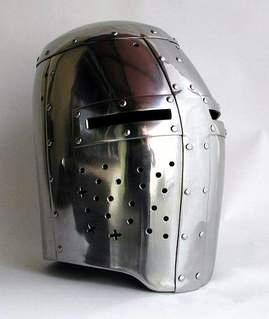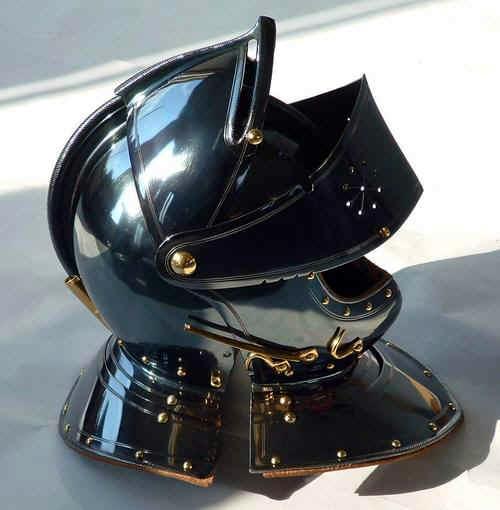GOTSCHA LAGIDSE
Spangenhelm, 2003, by Gotscha Lagidse, Master Armourer. This helmet is reconstruction of the helmet of an aristocrat Sir of Morken, found in the 6th century after CH., collection of the "Rheinischen Landesmuseums" in Bonn (Germany). Made with cooperation of the owner of the original helmet, the "Rheinischen Landesmuseums" in Bonn. Meaning was how the original helmet looked when it was made. The size and materiel is same as the original one. Also the decoration and the amount of holes. Leather and textile lining and fastening of mail is interpretation, but imaginable that they are interpreted correctly. The symbol on the front is also an interpretation because it was “missing”. Consisting of head piece, headband, and six bronze bands(Spangen) crests riveted with six pointed ovale steel leaves as fillings. Steel, bronze, leather and textile, gilding. Presented by Bruno Maurer - the Swiss Army Museum in Bern.
Topfhelm

Topfhelm, 2003. By Gotscha Lagidse, Master Armourer. Reconstruction of the helmet (ca.1300) from "The Collection Boissonas", France. Steel. Weight 6,5 kg. Presented by Bruno Maurer - the Swiss Army Museum in Bern.
Tournament helmet
Tournament helmet, 2007. By Gotscha Lagidse, Master Armourer. Reconstruction of the helmet (ca.1750) from , german. Steel. Weight 7,3 kg. Presented by Bruno Maurer - the Swiss Army Museum in Bern.
Salade
Salade, by Gotscha Lagidse, Master Armourer, 2004. Presented by The Museum "Nairac" in Barneveld, Holland. As a model for the helmet a beautiful painting by Friedrich Herlin, c. 1460, was chosen depicting St. George and the dragon, Stadtmuseum Nördlingen, Germany
Comb-cap
Comb-cap, by Gotscha Lagidse, Master Armourer, 2002/2003. Creation after the Dutch Comb-cap c.1620-1650 preserved at the Royal Netherlands Army and Arms Museum Delft. Material: iron, surfaces highly polished and blued fire’. The rivets and the plume holder gilt. Decorated with engraved lines, turned edges are finely cabled. Iron plates of different thickness 2 mm) were used to make the 5 separate parts, which form the helmet. The sheets of metal were forged cold as well as hot. The helmet contains about 75 iron rivets.
Cavalry helmet

1998. Cavalry helmet by Gotscha Lagidse, Master Armourer. Copy of The Dutch model personal helmet of Prince Maurice of Orange, c.1590, collection of the Hofjagd-und Rüstkammer des Kunsthistorischen Museums in Vienna. Description: Close-helmet with low comb, plume holder, riveted-on collar of two lames and a pivoting visor in three parts comprising: a brow reinforced with sights and a lifting stud on the right, face-guard with sights with ventilation holes on either side of the ridge consisting of 8 holes arranged in a small circle and linked to a central hole by double engraved lines and a lower bevor with the front half of the collar attached to it and held to the skull by a hook with an angular foot on the right; the face-guard in turn is held to the lower bevor by a similar hook, mounted on the right hand side as well. The face-guard is supported in the uplifted position by a long, swiveling forked stud and stud and when moved upwards also pushes the brow reinforce upwards due to the presence of the lifting-stud on the latter. Small nicks in the lower edge of the face-guard enable the fork to be adjusted in several positions so as to vary the height of the opening. Presented by the Royal Netherlands Army and Arms Museum Delft.
Miniature by Gotscha Lagidse, Master Armourer. Miniature 1:4, 1999. The personal suit of armour from the year 1590, form the collection of the Hofjagd- und Rüstkammer des Kunsthistorischen Museum in Vienna, served as inspiration. Presented by the Vissercollection in Wassenaar (Holland). Winner of a prize on an international forum exhibition in Bourglinster, Luxemburg - 1er prix Meilleure pièce exposée (1st prize for the best piece exhibited), at Luxembourg – Bourglinster, Forum International de la Ferronerie d’Art Contemporaine.
Boyhelmet, 2004
C. van Bruggen © Legermuseum
Boy's helmet by Gotscha Lagidse, Master Armourer in Holland, 2004. After the painting (1578-79) of Maurice Prince of Orange. The portrait is one of a series of eight paintings of members of the House of Orange. Artist unknown. Ordered by The Royal Netherlands Army Museum.
Muzaradi
Interpretation in Georgian style of the Indian type helmet, 1997. By Gotscha Lagidse, Master Armourer.
Chachkani

The Khevsurian(Georgian) helmet "Chachkani", 1995, by Gotscha Lagidse, Master Armourer.
Abjari
The Khevsurian(Georgian) Armour "Abjari", 1995, by Gotscha Lagidse, Master Armourer
Gotscha Lagidse, Master Armourer
Museum quality armour
Armour, helmets, swords etc. made by Gotscha Lagidse have found their way to prominent museums and private collectors in The Netherlands and abroad. Experts consider these objects as a class in their own. Not surprising because Gotscha’s works are based on historical study, a thorough knowledge of materials, unequalled craftsmanship and unconditional dedication.
Historically correct metal restorations
The same museum quality which is so characteristic for Gotscha’s arms and armour can be recognized in his restorations. With unrivalled precision he restores historic metal objects in their old lustre. It does not matter whether it concerns armour parts, swords, sabres, antique lanterns or a relatively modern object like a rare German ‘Falschirmjägergewehr’ from World War II.
About Gotscha
Gotscha Lagidse is born in 1965 in Georgia. Already at a very young age he has a strong interest in historic arms and armour. He studies these thoroughly and starts to reconstruct them. Once established in The Netherlands he leaves his marks with the reconstruction of the horseman’s armour of prince Maurits van Oranje-Nassau for the royal army museum in Delft. Various unique creations follow. Every one of these shows a very well developed artistic feeling and a drive for perfecton. Because of his merit with respect to the preservation of the Dutch cultural inheritance he has been awarded the Dutch nationality in 2005.
***
Gotscha Lagidse was born and raised in Georgia. This sunny country, rich by oldest culture and mythology, known by special lifestyle and traditions has natural influence on his works. Gotscha is working metal armours and small sculptures by means of technology, which has itself very big tradition in Georgia. By archaeologists were found specific Georgian armours, dated from XIII century before Christ. Greek historical of V century BC - Herodotus is mentioning about tradition of armour in Georgia. For Georgians armour is not only the defending attribute, but is also symbolizes the spiritual strength. That can be one of the reasons, why armours sometimes were presented to Christian churches.
One of the attributes of Georgian armours is a mail coat, which is made by sticking the rings together. Itself ring had different forms, which was dependent on the meaning of the work and the creative process of an artist. A mail coat, as well as other attributes of armour, was traditionally made with the creative artistic process. That's is why nearly every Georgian armour differs from any other - by its stylistic and creative independence. Gotscha, based on Georgian philosophical understanding of on armour, riser the old, nearly forgotten technology. He is making armours with the artistic creative process, creating new nuances of forms of the main parts or details. That is why his works in this direction have their strong identity and that is why they have high original artistic value. With the same unique technology he is creating small sculptures, which makes them very special. These sculptures have mainly round shapes, which give to them certain stylistic direction.
Gotscha's work is full of mystery and spirituality. In the work of Gotscha can be seen strongly indicated Christian symbols, - with the meaning of the basic spiritual fundament of humanity. But he is also creating personal symbols like: The Flower- symbol of beauty, the form of the boll - symbol of universality of the form or idea.
Dr. Z. Kalanda / art critics
Pronounced: gallery "Bremmer", Tilburg, 3 September 2000- opening of the exposition
The
World of Constant Connection - Informational and scientific magazine “, 3 (23)
2004, By Nino Chichinadze